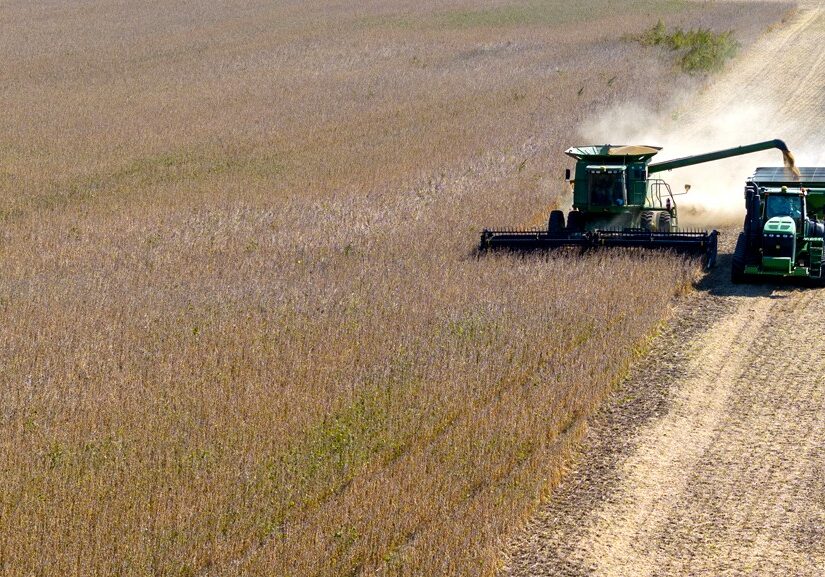Local Forums, EPA Raise Questions About SE Minnesota Water Quality | State Agencies Respond

SOUTHEAST MINNESOTA – Armed with support from the U.S. Environmental Protection Agency (EPA), organizations and rural residents are looking to state and local agencies to advance efforts to protect the region’s drinking water.
The central area of concern is the concentration of nitrates being found in private wells. The EPA is pressing several Minnesota state agencies to accelerate efforts to inform residents of potential health issues related to nitrates, as well as determining sources and solutions to reduce nitrate concentrations in drinking water supplies.
UPDATE: As expected, commissioners with Minnesota’s Department of Health, Department of Agriculture, and Pollution Control Agency responded in early December to the EPA’s November request for immediate action. In the December 1 response, state officials stated they “intend to address nitrate contamination in three phases: 1.) An immediate outreach program to again notify affected residents using private wells with known nitrate concentrations above the Maximum Contaminant Level and to provide alternate water to vulnerable populations; 2.) A public health intervention to ensure safe drinking water for private wells users in the mid-term in which well owner participation is voluntary; and 3.) Enhanced long-term environmental and conservation strategies to reduce nitrate concentrations in the aquifers that provide drinking water.” For complete details on the state’s actions, read our December 22 article on the state’s response.
Background: forums raise awareness
Area residents attending recent community forums held in Fillmore and Winona counties learned firsthand about specific issues and efforts underway to address nitrate pollution in southeast Minnesota.
At a November 16th Water Quality Forum in Lanesboro, Martin Larsen talked about the soil on his farm in Olmsted County. In addition to farming, Larsen is also a caver, and happens to be the Feedlot Officer for the Olmsted Soil and Water Conservation District (SWCD)

Martin Larsen, a farmer, caver, and feedlot officer in Olmsted SWCD, called karst geology a hidden drainage system that carries surface contaminants into the ground water. (Photo by John Torgrimson)
Pointing to a slide on a screen showing drone footage of an alfalfa field on his farm, Larsen pointed out visible lines lying just beneath the thin topsoil showing karst conduits, which leach surface water into the ground. It was a graphic image as to how contaminants can enter groundwater as nitrogen dilutes during rain events on the surface and runoff enters karst topography, the predominant landform in southeast Minnesota.
“This is a hidden drainage system,” Larsen told the crowd of 150 people assembled at Eagle Bluff Environmental Learning Center. “Karst systems are very complicated. Nitrogen is delivered into the subsurface via these conduits.”
As a caver and scientist, Larsen talked about collecting cave drip samplings underground. In one sampling beneath a Conservation Reserve Program (CRP) field, nitrogen tested at levels less than 1 part per million (PPM). A nearby crop field on the other hand tested at 16 PPM, well above the federal health safety standard of 10 PPM.
“Farmers don’t wake up in the morning and think ‘today I’m going to pollute the groundwater’,” Larsen said. “[Federal] Farm programs guide us in the way we do farming.”
Larsen was one of five speakers at the Forum, hosted by Responsible Ag in Karst Country (RAKC) on behalf of a coalition of local interest groups.
Others speaking at the forum were Paul Wotzka, hydrologist and Minnesota Well Owners Organization co-founder, on ecological disaster and the state of water in Fillmore County; Dr. Aleta Borrud, a retired physician with a Masters in Public Health in Epidemiology, on the health impacts of nitrates and other contaminants; Monta Hayner, with The Driftless Flyfishing Co., Preston, on the outdoor recreation economy; and Carly Griffith, water program director for the Minnesota Center for Environmental Advocacy (MCEA), on the role state agencies play in monitoring water quality.

Amy Bishop of Responsible Ag in Karst Country helped host the Water Quality Forum, attended by an estimated 150 people. (Photo by John Gaddo)
Forum speakers focused on a range of topics related to what they call a drinking water crisis in southeast Minnesota. Topics included the role karst geology plays in private well water quality; the impact water contamination has on public health; the role regenerative farming can play in mitigating groundwater contamination; the economics of clean water; and the role state agencies play in monitoring water quality.
A similar forum, called Resource in Crisis, was held at Winona State University in October, organized by the Winona Clean Water Coalition. (A video recording of the Lanesboro Water Quality Forum is available on the RAKC Facebook page.)
Environmental protection agency demands action
In a letter to state agencies dated November 3, 2023, the United States Environmental Protection Agency (EPA), told the state of Minnesota it needed to take action on nitrate pollution of groundwater in eight southeastern Minnesota counties in the karst region: Dodge, Fillmore, Goodhue, Houston, Mower, Olmsted, Wabasha, and Winona counties.
Responding to a petition brought forth in April 2023 by several regional clean water, health, and environmental organizations, the federal agency asked the Minnesota Pollution Control Agency (MPCA), Minnesota Department of Health, and Minnesota Department of Agriculture to intervene to prevent a public health threat related to safe drinking water in the karst region.
Karst geology consists of fractured limestone bedrock and thin topsoil (less than 50 feet) that allows surface water to enter groundwater with little or no filtration. Karst is evidenced by sinkholes, caves, and streams. In Fillmore County alone, there are more than 10,000 sinkholes. Department of Natural Resources dye tracings have shown that surface water that goes into the ground can travel up to 10 miles underground from a source point.

Monta Hayner, fly fishing guide and Women’s Outreach and Marketing Director with the Driftless Fly Fishing Company in Preston, talked about the impact outdoor recreation has on the local economy. She told the audience “the quality of our streams is directly related to the quality of the groundwater.” (Photo by John Gaddo)
Contaminants on the land can enter the groundwater via a rain event or spring thaw. According to the MPCA, more than 70 percent of nitrate contamination comes from agricultural practices that include applying liquid nitrogen before planting or the application of animal manure to fields.
Noting that approximately 300,000 people residing in this eight-county karst region rely on public water systems and an estimated 94,000 people use private wells, the EPA estimates that there are over 9,000 people at risk of consuming water at or above the maximum contaminant level (MCL) for nitrate [10 milligrams-per-liter (mg/l) or 10 parts per million]. Nitrate pollution has been linked to Blue Baby Syndrome as well as birth defects and a range of cancers.
A 2017-2018 testing program conducted by the Minnesota Department of Agriculture in conjunction with the Fillmore Soil and Water Conservation District looked at nitrate levels in 1,417 wells in all 24 townships in Fillmore County found that 17 percent of the wells had nitrate levels above the Health Risk Limit of 10 mg/l — the EPA’s threshold for preventing Blue Baby Syndrome.
What the EPA’s letter to state agencies says
“EPA’s immediate priority is to protect human health by ensuring that residents impacted by nitrate contamination are: (1) identified; (2) provided notice in all applicable languages regarding their potential exposure to elevated nitrate concentrations and information regarding the associated health risks; and (3) provided the opportunity to obtain alternate drinking water until nitrate contamination in groundwater falls below the MCL for nitrate of 10 mg/L.
“EPA expects state agencies to take timely actions to address the nitrate contamination, especially with respect to providing public notice and alternate water. To address these priorities, EPA requests that the Minnesota agencies develop a coordinated and comprehensive work plan to identify, contact, conduct drinking water testing and offer alternate water to all impacted persons in the Karst Region, as soon as possible, and to sustain these efforts for as long as nitrate concentrations in the groundwater of the Karst Region remain at or above the MCL.”
While the letter focused on immediate health concerns, the EPA called on the state to “develop a complete understanding of potential sources of nitrate contamination” and “use all available resources to effect reductions in nitrate concentrations.” The EPA expected the state to respond to its letter within 30 days; the state’s response and action plan was released December 1.
Public health
Dr. Aleta Borrud spoke at both recent forums about the public health risks nitrate contamination of drinking water have been linked to. Borrud cited a 30-year study in Denmark that showed a direct link to colorectal cancer at nitrate levels greater than 4 mg/l. Other studies have shown nitrate contaminant risks to fetuses, Blue Baby Syndrome in infants, and a range of cancers in adults, including colorectal, kidney, thyroid and ovarian.

Aleta Borrud, is pictured at the Winona forum in October. Borrud discussed the public health implications of nitrate contamination in drinking water. (Photo by Martin Moore)
“Safe levels of 10.4 mg/l should not be considered safe, in order to protect us from these cancers,” Borrud said. The EPA’s maximum contaminant level of 10.4 mg/l was set in 1962.
The Minnesota Center for Environmental Advocacy’s Carly Griffith said that due to the potential health risks of nitrate contamination, the EPA is “taking up a new assessment of nitrates, to widen the scope beyond Blue Baby Syndrome and react to the new research on cancers.” She went on to say that the current resources for contaminated wells is inadequate to meet the water crisis in this region.

Driftless Fly Fishing Company in Preston. According to Monta Hayner, outdoor recreation accounts for 2.4 percent of Minnesota’s gross national product. (Photo by John Torgrimson)
Congressman Finstad responds to EPA letter
While the EPA’s letter has been welcomed by many, not everyone is happy with the agency’s actions. Minnesota Congressman Brad Finstad, R-1st District, a member of the House Committee on Agriculture, accused the federal agency of “targeting Minnesota farmers at the behest of environmental extremists.” A fourth-generation farmer from the New Ulm area, Finstad called the petition “non-science based” and the petitioners “anti-agriculture”.
In a letter to regional EPA administrator Debra Shore, Finstad said he was disappointed in the manner in which the federal agency investigated the issue, claiming investigators turned up unannounced at local farms. Finstad also raised several questions about how the on-site inspections were conducted.
Finstad ended his letter by stating that “farmers work every day to produce the highest quality, lowest cost food and fuel supply in the world while leaving their soil and water better for generations.” He called on the EPA to work to rebuild trust by improving communication and transparency.
In response to a Water Quality Forum question regarding Congressman Finstad’s letter, Olmsted County farmer Martin Larsen said, “How I farm is real. I look for solutions that are collectively positive and substantiated by peer farmers… What I say up here is backed up by science.” As a farmer, he said, “I want to be part of the solution.”
Well testing options are available from the Fillmore Soil and Water Conservation District (SWCD) in Preston. For well testing in other counties, contact your local SWCD office or local health department. ………………… Additional Articles On Water Quality Published By Root River Current: Minnesota Launches First Phase of Nitrate Mitigation Plan Southeast Minnesota Runoff Pollutes Beyond Local Area Minnesota Nitrate concerns inspire Iowa groups to seek EPA help Nitrate and Water Issue Proposals Addressed by 2024 Minnesota Legislature State Officials: January 2024 Plan Addresses Nitrate Contamination Issues What Happens When Feedlots Get Bigger in Karst Country? Walk The Walk And Talk The Talk, Too looks at how area farmers are working to achieve their goals for land stewardship, their families and communities. Root Causes, Root Solutions explores a Houston County dairy farmer’s practices to control runoff and soil erosion.Well Screening opportunities






